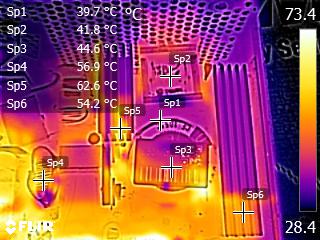Seasonic Focus SGX 500W SFX-L Power Supply Review: Top Performance In A Small Package
Why you can trust Tom's Hardware
Protection Features, DC Power Sequencing, Cross-Load Tests and Infrared Images
Protection Features
Check out our PSUs 101 article to learn more about PSU protection features.
| Protection Features | |
| OCP | 12V: 50.8A (123.9%), 11.976V 5V: 27.9A (139.5%), 4.988V 3.3V: 25.6A (128%), 3.311V 5VSB: 6.2A (206.67%), 5.037V |
| OPP | 620.3W (124.06%) |
| OTP | ✓ (168°C @ 12V Heat Sink) |
| SCP | 12V: ✓ 5V: ✓ 3.3V: ✓ 5VSB: ✓ -12V: ✓ |
| PWR_OK | Proper Operation |
| NLO | ✓ |
| SIP | Surge: MOV Inrush: NTC Thermistor & Bypass Relay |
The over current protection (OCP) at +12V and 3.3V is properly set, but it is a little higher than the optimal (130%) at 5V. The 5VSB's triggering point is too high, but this doesn't create any load regulation problems. Finally, the over power protection (OPP) triggers at 620.3W, effectively protecting the PSU under all operating conditions.
There is over temperature protection which is set at a high level in order to avoid any problems with the semi-passive operation.
DC Power Sequencing
According to Intel’s most recent Power Supply Design Guide (revision 1.4), the +12V and 5V outputs must be equal to or greater than the 3.3V rail at all times. Unfortunately, Intel doesn't mention why it is so important to always keep the 3.3V rail's voltage lower than the levels of the other two outputs.



The 3.3V rail is always lower than the other two rails, so no problems here.
Cross Load Tests
Get Tom's Hardware's best news and in-depth reviews, straight to your inbox.
To generate the following charts, we set our loaders to auto mode through custom-made software before trying more than 25,000 possible load combinations with the +12V, 5V, and 3.3V rails. The deviations in each of the charts below are calculated by taking the nominal values of the rails (12V, 5V, and 3.3V) as point zero. The ambient temperature during testing was between 30 degrees Celsius (86 degrees Fahrenheit) and 32 degrees Celsius (89.6 degrees Fahrenheit).
Load Regulation Charts



Efficiency Chart
We would like to see a region, even a small one, with higher than 92% efficiency.
Ripple Charts
The lower the power supply's ripple the more stable the system will be and less stress will be also applied to its components.




Infrared Images
We apply a half-load for 10 minutes with the PSU's top cover and cooling fan removed before taking photos with a modified FLIR E4 camera able to deliver an IR resolution of 320x240 (76,800 pixels).








The highest temperature that our IR camera recorded is 88.4 degrees Celsius, which is not so low but not very high either. The area right in front of the DC-DC converters, looks to be the hottest one.
MORE: Best Power Supplies
MORE: How We Test Power Supplies
MORE: All Power Supply Content
Current page: Protection Features, DC Power Sequencing, Cross-Load Tests and Infrared Images
Prev Page Load Regulation, Hold-Up Time, Inrush Current, Efficiency and Noise Next Page Transient Response Tests, Ripple Measurements and EMC Pre-Compliance Testing
Aris Mpitziopoulos is a contributing editor at Tom's Hardware, covering PSUs.
